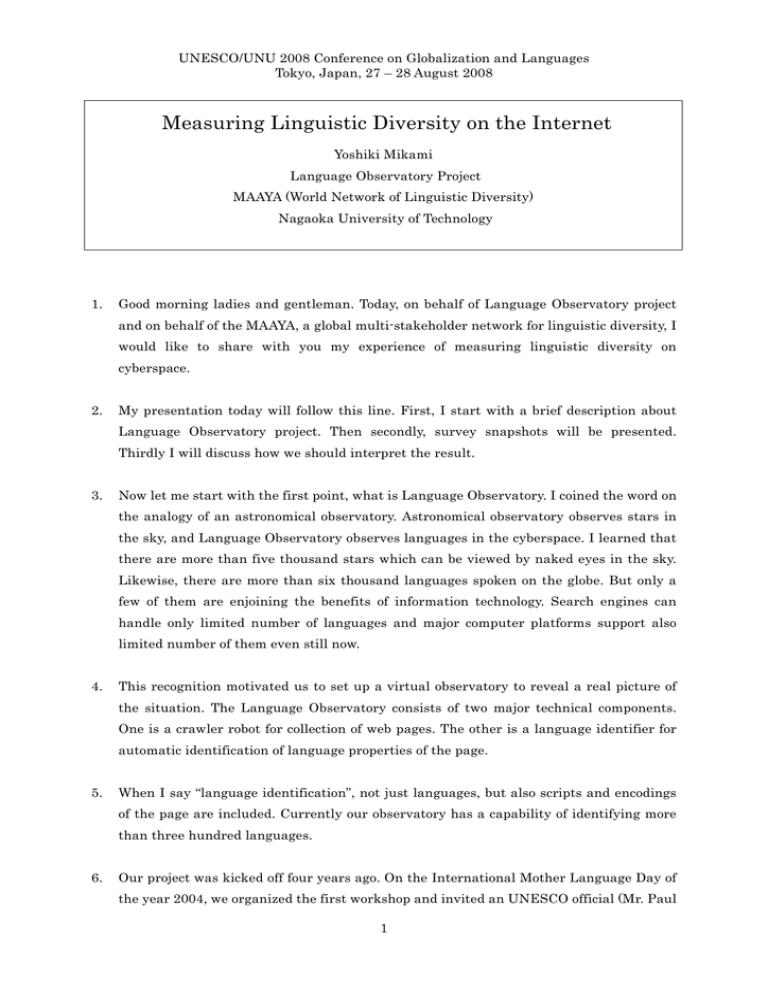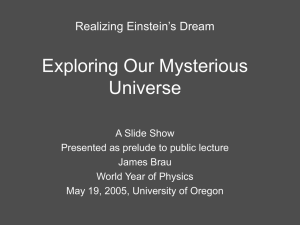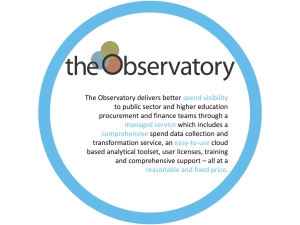Measuring Linguistic Diversity on the Internet
advertisement

UNESCO/UNU 2008 Conference on Globalization and Languages Tokyo, Japan, 27 – 28 August 2008 Measuring Linguistic Diversity on the Internet Yoshiki Mikami Language Observatory Project MAAYA (World Network of Linguistic Diversity) Nagaoka University of Technology 1. Good morning ladies and gentleman. Today, on behalf of Language Observatory project and on behalf of the MAAYA, a global multi-stakeholder network for linguistic diversity, I would like to share with you my experience of measuring linguistic diversity on cyberspace. 2. My presentation today will follow this line. First, I start with a brief description about Language Observatory project. Then secondly, survey snapshots will be presented. Thirdly I will discuss how we should interpret the result. 3. Now let me start with the first point, what is Language Observatory. I coined the word on the analogy of an astronomical observatory. Astronomical observatory observes stars in the sky, and Language Observatory observes languages in the cyberspace. I learned that there are more than five thousand stars which can be viewed by naked eyes in the sky. Likewise, there are more than six thousand languages spoken on the globe. But only a few of them are enjoining the benefits of information technology. Search engines can handle only limited number of languages and major computer platforms support also limited number of them even still now. 4. This recognition motivated us to set up a virtual observatory to reveal a real picture of the situation. The Language Observatory consists of two major technical components. One is a crawler robot for collection of web pages. The other is a language identifier for automatic identification of language properties of the page. 5. When I say “language identification”, not just languages, but also scripts and encodings of the page are included. Currently our observatory has a capability of identifying more than three hundred languages. 6. Our project was kicked off four years ago. On the International Mother Language Day of the year 2004, we organized the first workshop and invited an UNESCO official (Mr. Paul 1 UNESCO/UNU 2008 Conference on Globalization and Languages Tokyo, Japan, 27 – 28 August 2008 Hector) to witness the launching event. The event was reported through UNESCO’s web news site. 7. UNESCO adopted so-called cyberspace recommendation just a few months before the launch of Language Observatory project. Measurement of linguistic diversity on cyberspace is one of the key issues addressed in the recommendation. 8. The funding given by Japan Science and Technology Agency (JST) helped us to equip a fleet of server computers. Also various technical supports given by our international collaborators helped us to implement the project successfully. UbiCrawler, a powerful crawler software developed by a team of Milano University in Italy helped us a lot. 9. This slide is a snapshot of experts who joined to the African Web Language Survey Workshop organized in Bamako, the capitol of the Republic of Mali, in 2006. This event was made possible by the strong initiative of Mr. Adama Samassekou. On this occasion, I would like to express my sincere appreciation and thanks to him for his continuing wonderful support. 10. Then I move on to the second part, and give a brief report of the survey result. Because of the tremendously huge size of the cyberspace, it is impossible for us to survey entire web space. It is estimated to be in the order of tens of billions of pages. So we decided to focus our efforts on only country domains in Asia and Africa. This slide shows language compositions of web pages of 34 Asian countries. Note that China, Korea and Japan are not included because of its huge size. As you notice, local languages have a majority share only in a limited number of country domains, namely Turkey, Israel, Iran and a few Arabic speaking countries in the Middle East, Thailand, Indonesia and Vietnam. Light-blue color represents an English portion, and not-surprisingly it occupies majority or even more than ninety percents of pages in several country domains. 11. This slide lists up top ten Asian local languages with their respective speaking population and number of pages we found on the web. Hebrew comes on top and is followed by Thai, Turkish, Vietnamese, Arabic and etc. 12. In the African continent, the situation seems far worse. More than sixty country domains in Africa are grouped into three language groups, the English speaking (Commonwealth), Francophonie and Arabic speaking countries. Not-surprisingly again, English and French occupies majority share in each of them. But the presence of African local languages is almost negligible in all groups. 2 UNESCO/UNU 2008 Conference on Globalization and Languages Tokyo, Japan, 27 – 28 August 2008 13. Top ten African local languages are shown in this slide together with their speaking region and the number of pages we found on the web. Malagasy, an official language of Madagascar, comes on top and is followed by Swahili, Afrikaans, Krio, Kinyarwanda, etc. But please note that the presence of those African local languages is far smaller than that of Asian languages. They are merely in the order of thousands at best. 14. The previous four slides told us of the existence of serious gap between languages. We may call this “Digital Language Divide”. In the following section, I would like to discuss about how the result should be interpreted. First, let me present a few data in economic context. This slide shows distribution of population and level of communication access of countries with different income categories. High income countries on the right and low income countries on the left, and two graphs correspond to 1999 and 2004. Clearly telephony, mobile hone access in particular, shows big improvement during this five years. 15. Economists always refer to GINI coefficient when they talk about income inequality. If we plot accumulated population on the horizontal axis and accumulated income on the vertical axis, it results a curve called “Lorenz curve”. The greater bending of the curve means the bigger inequality of income. I borrowed this concept to measure the gap in cyberspace. 16. This chart shows the Lorenz curves of four indicators, GDP, the number of fixed line telephones, the number of mobile subscribers and the number of host computers connected to the Internet. GINI coefficient of telephony is 0.73. It is below that of GDP. Namely inequality found in telephone access is now less than income inequality. But the inequality of host computers is still bigger than that of income. This analysis clearly addresses that telephony has been improved but internet access is still not. 17. Secondly I would like to introduce a factor from technical point of view. This is a map of the world colored by scripts used to represent mother languages of the region. As you can see, most part of the world is marked with two slightly different yellow colors, which corresponds to Latin and Cyrillic alphabet. Pink color means Arabic and is used in northern Africa and Middle East. But the Asian continent looks like a patch work of many different color kilts, and this has created a special technical difficulty in the region. 18. One old day record exemplifies this difficulty. A letter written by a Jesuit friar four hundred years ago says that the difficulty to cast more than six hundred moulds of type 3 UNESCO/UNU 2008 Conference on Globalization and Languages Tokyo, Japan, 27 – 28 August 2008 was an obstacle to print a book in local language with local script there at that time. 19. Another case of early days printing, a case of “Doctrina Christiana” printed in Manila gives us an idea what would happen in the worst case. The book shown in this slide was printed in three versions, Tagalog in Tagalog script, Tagalog in Latin script and Spanish in Latin script. During the first hundred years after the first printing, Tagalog script, as shown in the center of this slide, was completely lost. Now only quite few Philippine people can notice the motif designed in a postal stamp issued in 1995 is their ancestors’ script. 20. Let me show you my typewriter collection. This is not just a classic typewriter collection. It is a collection of typewriters localized to different languages. From top to bottom and from left to right, there are Tamil, Bengali, Sinhalese, English, Hindi, Korean, Myanmar and Thai. It is surprising for me to find that all typewriters have similar shape and almost same number of keys while set of letters of those languages are quite different in size. Why? Typewriters had been localized with big degree of compromising omission of letters and of complicated superimposition of multiple strokes, all of which were not always happy for local users. 21. As explained in three cases difficulties in language localization had been the key obstacle to the spread of new information technologies since type printing age. I assumed that the central factor in localization efforts in the computer age is character encoding issues. 22. This assumption is confirmed by this table. Top five languages are those languages which have substantial presence on cyberspace, and they all have a well established encoding standard for their scripts encoding. On the contrary, bottom four languages are suffering encoding chaos and quite less presence on the web. 23. Thirdly I would like to introduce socio-cultural context. Language activities of the people have various domains. Here I took a framework for analysis from European Union document. The document defines four domains, personal, public or governmental, occupational or business, and educational domains. 24. In a monolingual society like Japan, four domains are filled with the same single language. But in multilingual societies different language works in a different domain. For example, a global language like English or French works in educational domain and occupational domain, but very local, even minority dialect works in personal life. If we can analyze language composition found in the secondary level domains of each country, 4 UNESCO/UNU 2008 Conference on Globalization and Languages Tokyo, Japan, 27 – 28 August 2008 the result would illustrate a picture of specialization of each language. 25. A few sample survey results of four countries, Cyprus, Turkey, Kazakhstan and Iran, are shown here. We can see higher percentage of English in educational domains in all four countries and higher percentage of official or local languages in personal communications in most of countries. 26. Now I would like to conclude my presentation. As presented in the second part of my presentation, Digital Language Divide is observed in Asian and African country domains. Behind this divide, I assumed three factors, which correspond to economic, technical and socio-cultural context respectively. From economic context, less access opportunity in less income countries would be one factor behind. From technical context, I mentioned the special difficulty in localization. It is particularly serious for non-Latin users. From socio-cultural context, I have drawn attentions to less presence of local languages in educational and occupational domains. It means that empowerment of local language is really needed. Regarding the future of Language Observatory, I have a vision looking forward two directions. One is to develop a language specific search engines on the basis of our technical infrastructure. Language identification and crawler robot are the key element for language specific search engines too. Another one is to develop a network of language observatories in a global scale. I hope some audience agrees to join to this direction and work together in future. 27. Lastly let me introduce one more slide. This shows a part of members of Maaya network. Today I bring a brochure of the network. If you have interest in this network please contact me later. 5





